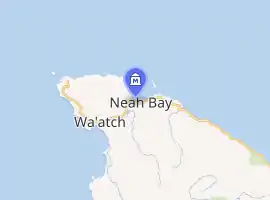Makah Museum
The Makah Museum also known as the Makah Cultural and Research Center is an archaeological and anthropological museum on the Makah Indian reservation in Neah Bay, Washington. It houses and interprets artifacts from the Ozette Indian Village Archeological Site, a Makah village partly buried by a mudslide at Lake Ozette around 1750,[1] providing a snapshot of pre-contact tribal life. The museum includes a replica long house and thousands of artifacts of interest to academics and laypeople, including canoes, basketry, whaling and fishing gear.[2][3][4]

| |
| Established | 1979 |
|---|---|
| Location | Neah Bay, Washington, USA |
| Coordinates | 48°22′02″N 124°37′25″W |
| Type | Archaeological and anthropological museum |
| Collection size | Artifacts from Ozette dig |
| Owner | Makah Tribe |
| Website | makahmuseum |
The museum was created under the leadership of tribal chairman Edward Eugene Claplanhoo and opened in 1979, soon after the Lake Ozette site was unearthed.[5][6]
References
- Prehistoric Cultures of North Americas. Crouthamel, American Indian Studies/Anthropology, Palomar College
- Makah Cultural and Research Center, Fodors, retrieved 2013-03-19
- Brian J. Cantwell (February 16, 2011), "Stormwatching and cultural riches in Neah Bay", The Seattle Times, retrieved 2013-03-19
- Patricia Pierce Erikson (October 1, 2005). Voices of a Thousand People: The Makah Cultural And Research Center. U of Nebraska Press. ISBN 0803267568.
- "Hundreds mourn Makah leader's death in Neah Bay", The Seattle Times, March 21, 2010, archived from the original on March 16, 2014, retrieved 2013-03-19
- Steury, Tim (Summer 2008), "A Dialogue with the Past: Modern Archaeology in the Pacific Northwest and What We Are", Washington State Magazine, Washington State University, retrieved 2013-03-20
External links
| Wikimedia Commons has media related to Makah Museum. |
This article is issued from Wikipedia. The text is licensed under Creative Commons - Attribution - Sharealike. Additional terms may apply for the media files.